Content marketing is an integral aspect of building a successful startup. Not only does it help in establishing authority and credibility in the market, but it also serves as a cost-effective method for customer acquisition.
In this guide, you’ll learn step-by-step how to create a content marketing strategy for your startup business.
Why Content Marketing is Crucial for Startups
Most startups operate on a tight budget. It’s mostly not feasible for most of them to launch multiple marketing strategies.
This is where content marketing comes in.
Content marketing gives startups the gateway to reach their target audiences without high upfront and recurrent budgets.
Compared to other marketing methods, such as paid ads or influencer marketing, content marketing is cost-effective for building brand awareness.
Besides, content marketing has a long-term impact. If maintained well, blog posts, case studies, guides, videos, and lead magnets can generate organic traffic for years.
On top of that, content marketing can help your startup:
- Build authority- Constantly publishing good content can help startups establish themselves as thought leaders in their industries.
- Boost customer engagement- Content marketing opens a channel for two-way communication between you and your target audience.
- Increase conversions- Great content supports your sales funnel and helps move your clients to the point of purchase.
Read the following guide to learn more about how content marketing can benefit your business.
Steps to Create a Content Marketing Strategy For Startups
Here are the steps to create an effective content marketing strategy for your startup:
- Define Your Target Audience and Create Personas
- Analyze Your Competitors
- Set Your Business Objectives
- Do a Thorough Keyword Research
- Create a Content Calendar
- Start Creating Content
- Create a Content Promotion Plan
- Track KPIs to Gauge Effectiveness
1. Define Your Target Audience and Create Personas
The main goal of a content marketing strategy is to reach your target audience and attract more customers.
Defining your target audience will help you understand their pain points, needs, and desires and then create content to address them.
Creating buyer personas is a great first step. A buyer persona is a detailed description of your startup’s ideal customer.
You can use this template as your guide.
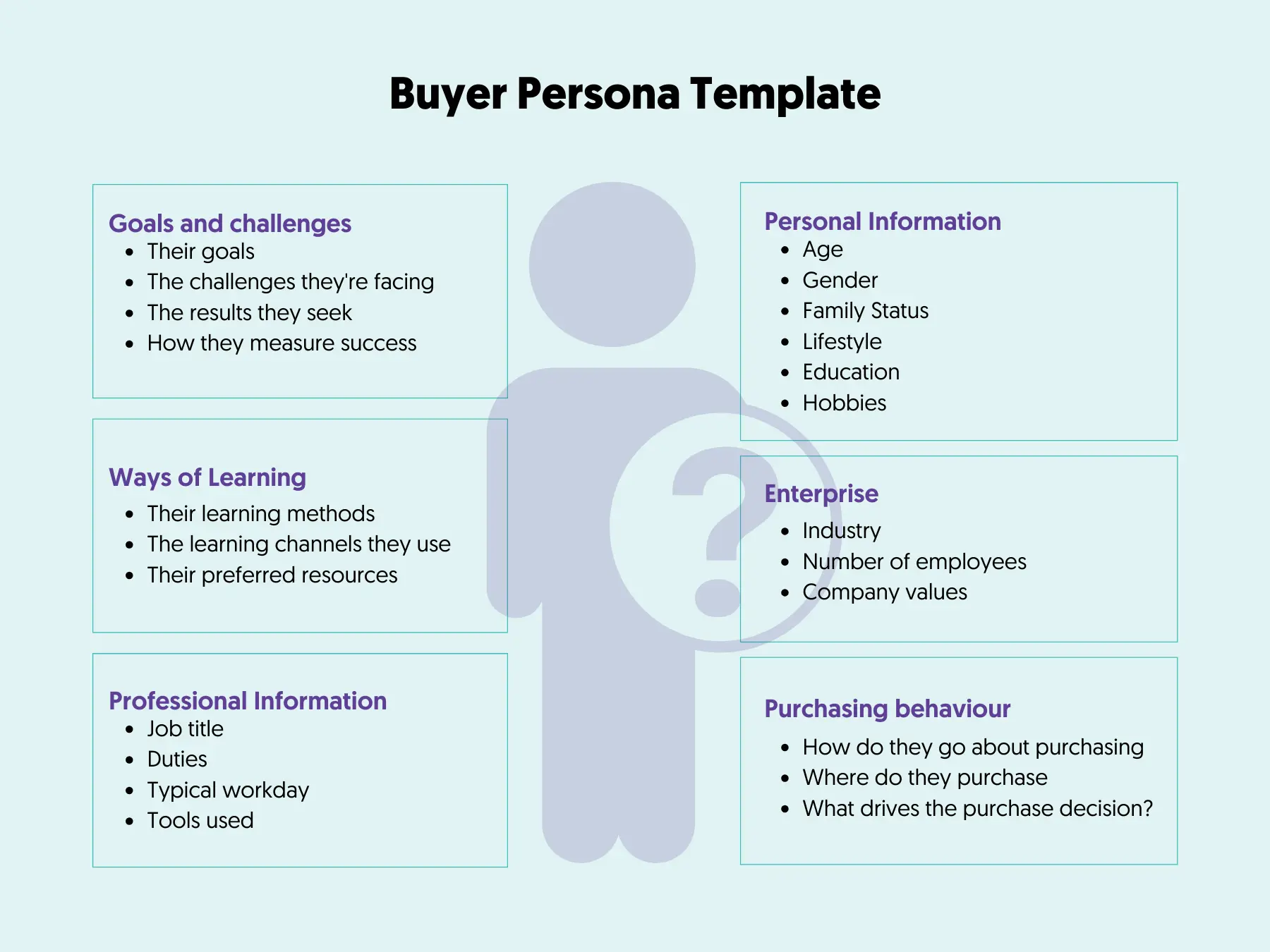
Persona demographics- Demographics are the characteristics of your target audience and are related to individual identity. Examples of demographics to include in your buyer persona template include age, location, sex, family status, and level of education.
Professional information- Include whether your ideal clients are employed, unemployed, or self-employed. Their employed status details should include industry, job title, level of seniority, work arrangement (remote or in office), and income.
Psychographics- Psychographics are your audience’s values, personalities, attitudes, and interests. Psychographic information includes your target audience's lifestyles, political views, beliefs, and values.
Ways of learning- What are your target audience’s preferred ways of consuming information? Do they prefer blog articles, case studies, YouTube videos, or social media posts? Which learning platforms do they prefer? Who are their favorite influencers and industry experts?
Goals and challenges- Seek to understand what your buyer personas are seeking to achieve when they visit your website. Understand their pain points, frustrations, and dissatisfactions so you can create solutions addressing them directly.
Purchasing behavior- How do your customers go about their purchasing process? Seek to understand where they purchase, what drives their purchasing decisions, and their role in the decision-making process.
You can collect the information for your buyer personas using surveys, interviews, and focus groups.
Don’t be afraid to write and optimize content that communicates directly to a specific customer base. This will help you connect more with them in a significant way.
2. Analyze Your Competitors
Conducting a competitor analysis will help you identify what your competitors are doing right and spot gaps that you can fill.
Your goal is to use insights from your competitors’ strategies to strengthen your content strategy.
Make notes about:
- Which platforms do they post their content on?
- What type of content gets the most engagement?
- How much do they pay for ads?
- What are their top-performing pages?
Use insights from your target audience research to identify topics that your audience loves, but your competitors haven’t covered. This will give you a competitive edge.
Read the following guides to learn how to unveil your competition’s SEO and Paid ads tactics.
3. Set Your Business Objectives
Identifying your business objectives will help you align your startup content marketing strategy with your goals and create the right type of content that resonates with your audience.
Your business objectives should be SMART:
- Specific- Define what exactly you want your content marketing to help you achieve
- Measurable- Set key performance indicators and metrics to evaluate your content marketing strategy.
- Achievable- Evaluate whether you can achieve these goals with your current resources and skills
- Relevant - Ensure that the goals you set are aligned with your startup's mission, vision, and current business objectives.
- Timely- Set deadlines for these goals. Also, define how much of your resources you’ll invest within a specific timeframe.
Here is an example of SMART goals you can set:
Specific - Boost our brand’s ranking on result pages for the target keyword “content marketing for startups” by creating optimized content to rank higher than our competitors.
Measurable - Climb from 12th position on Google search results to 1st, 2nd, or 3rd.
Achievable - Boost organic traffic to increase engagements, brand authority, and awareness.
Relevant - Our mission and vision is to become a leading source of industry information. Ranking higher on search engine results will increase our authority in our industry.
Timely - By the end of this year.
4. Do a Thorough Keyword Research
Keywords are important to your content marketing strategy. Using the right keywords will help you get targeted traffic to your website.
Targeted traffic will lead to a higher conversion rate and a positive ROI from your content marketing investment.
You can start your research by finding trending topics that are relevant to your industry.
Go to Google Trends and search for your topic. Look for the "Related Queries" section and go through the "Rising" and "Top" queries.

Select the most relevant queries and search for specific keywords for your campaigns using a keyword research tool.
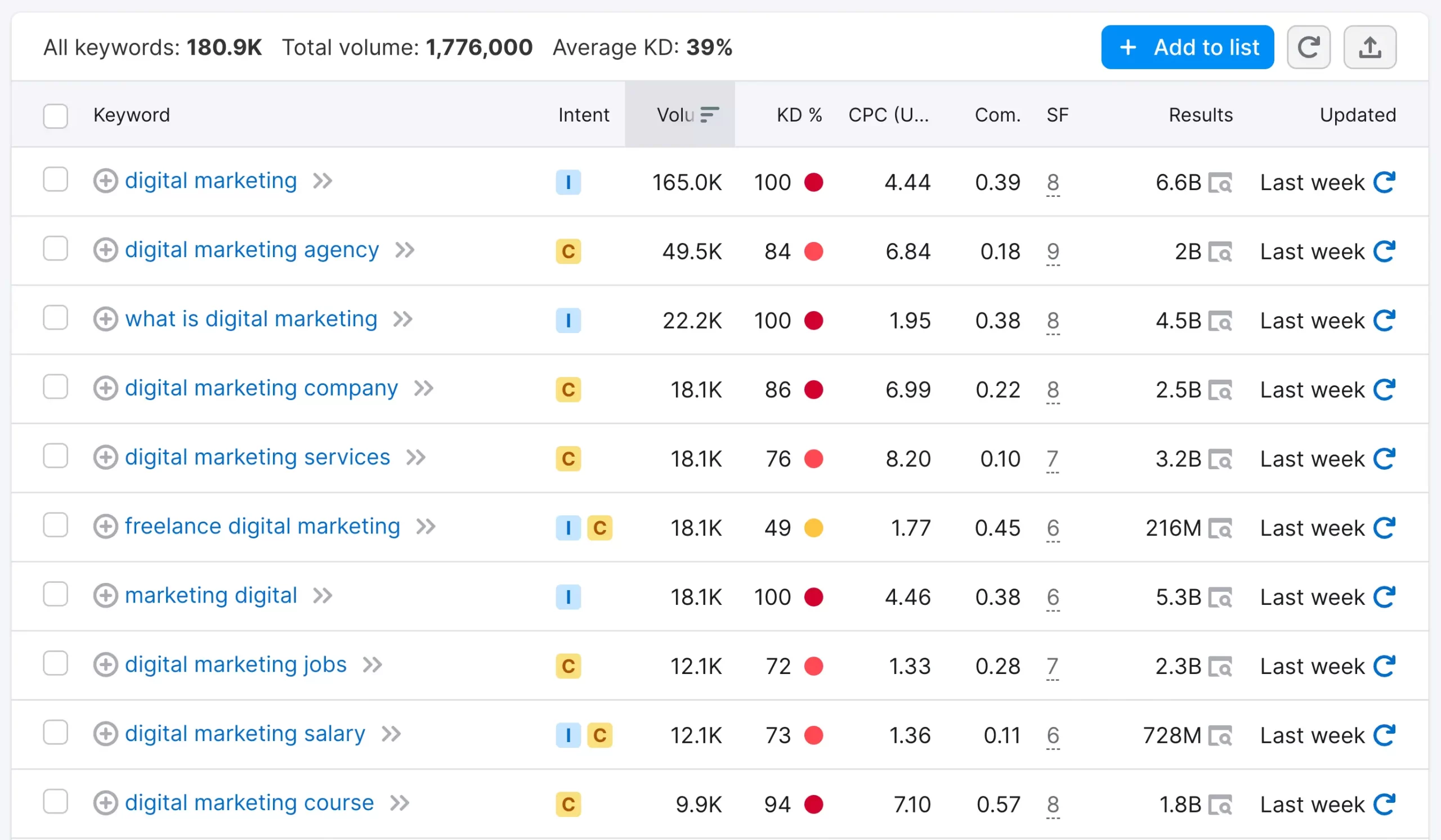
Analyze your data further and concentrate on long-tail keywords.
Long-tail keywords target specific visitors who already know what they want. They are easier to rank and perfect for becoming an authoritative resource for your niche.
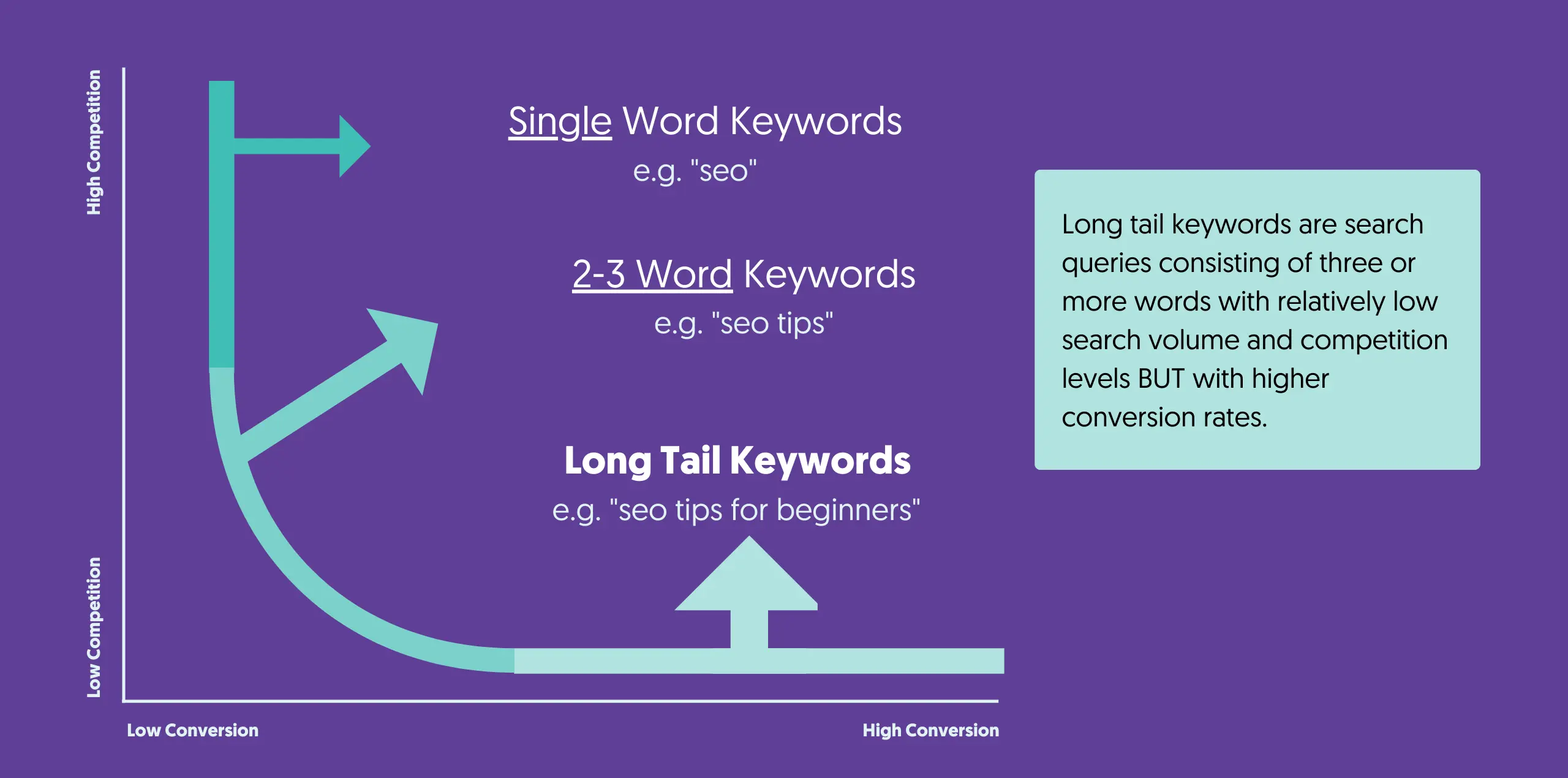
Pro Tip: You can also perform a competitor keyword analysis and find out which keywords work for your competitors and adjust your strategy accordingly.
5. Create a Content Calendar
A content calendar is an essential aspect of content marketing for startups.
Your calendar will help you spell out what type of content you need to create, when you’ll create it, where you’ll publish it, and how you’ll distribute it.
A good content calendar can be your team’s most important content management tool. It ensures you consistently produce high-quality content that supports your business objectives.
Here are some tips on what to include in your startup’s content calendar:
When to publish new content- decide on the frequency of publishing new content and stick to a consistent schedule.
This helps you organize your time and resources better and sets audience expectations. Your audience will know when to expect new content from you, which will eventually lead to creating a community of brand followers.
When to update top-performing content - If you have a website, audit your existing content. Find your top-performing pages and make sure that you set specific dates on when to update and revise them.
Updating your top content once every couple of months is essential to maintain your Google rankings and keep your content relevant.
In addition to the content calendar, you need to formulate a workflow.
Basically, your workflow needs to include the steps your content takes from ideation to publishing. It also notes down who is responsible for what.
A good workflow helps your team work as efficiently as possible.
The key to creating a good workflow is clearly defining every step in executing your content creation strategy, including your preferred content types and formats, channels, content team, creation tools, and content calendar.
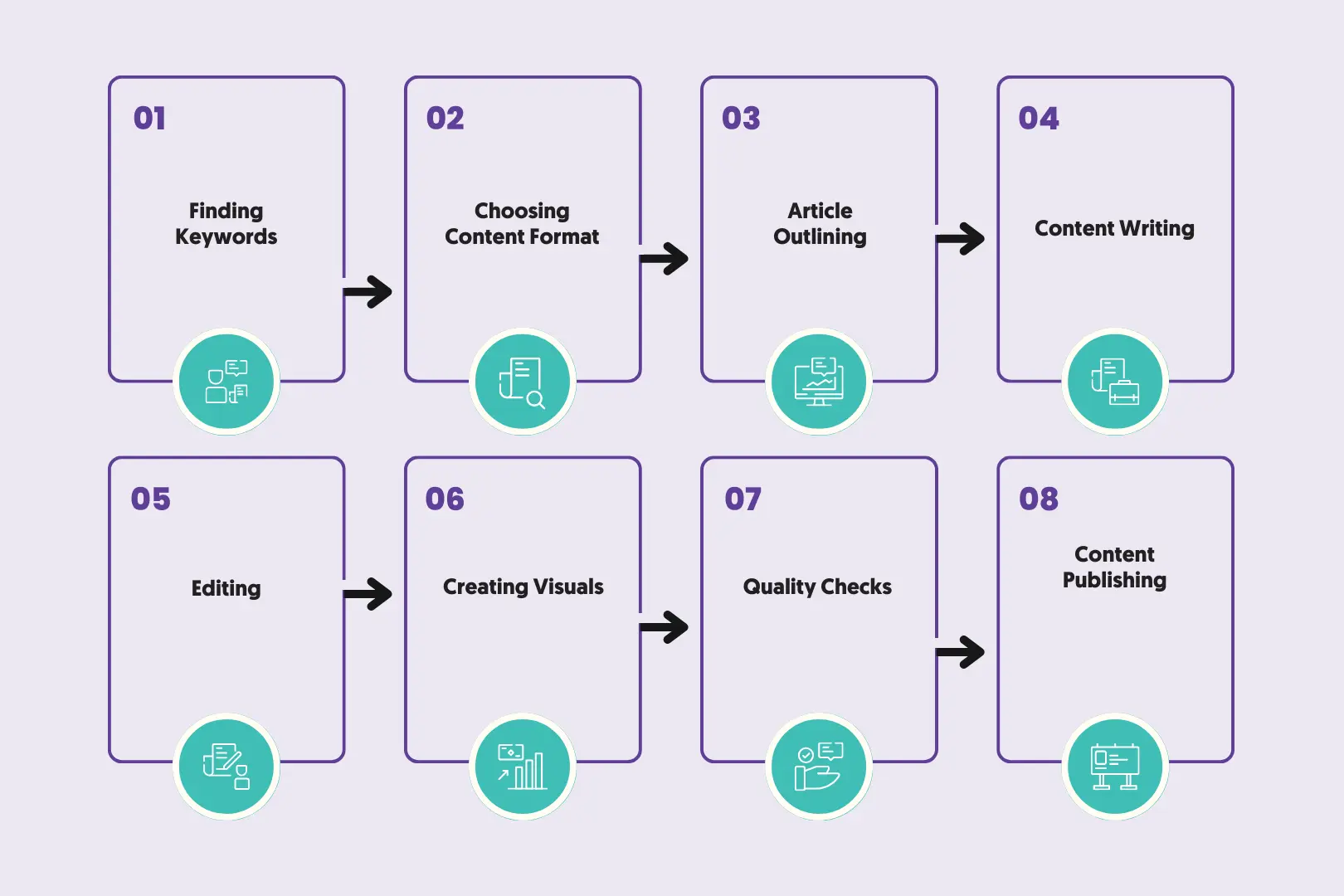
Here’s an example of a good workflow:
- Finding keywords
- Choosing content format
- Article outlining
- Content writing
- Editing
- Creating visuals
- Quality checks
- Content publishing
Assign each step to members of your team so that it can be accounted for.
6. Start Creating Content
Search engines rank high-quality content that gives readers unique perspectives.
Offer your expert perspective based on experience and use it to create diverse content that answers your readers’ questions.
Keep in mind that valuable content will always outrank your competitors, regardless of their SEO or content strategies.

High-quality content has the following characteristics:
- Provides original information
- It is comprehensive and goes in-depth into the topic
- Offers new insights beyond the obvious
- Uses a main heading or title that gives the readers a summary of the content
- Provides substantial value compared to other pages on the search results
- Contains no spelling, grammar, or stylistic issues
- Well produced in no rush
7. Create a Content Promotion Plan
Content promotion is a vital aspect of content marketing. It’s not just enough to write content and post it on your blog. You need to ensure your readers see it.
A content promotion plan will ensure your hard work is seen and generate the numbers it deserves.
Your content distribution strategy needs to spell out which platforms you plan to use for promotion, when, and how you’ll promote the content.
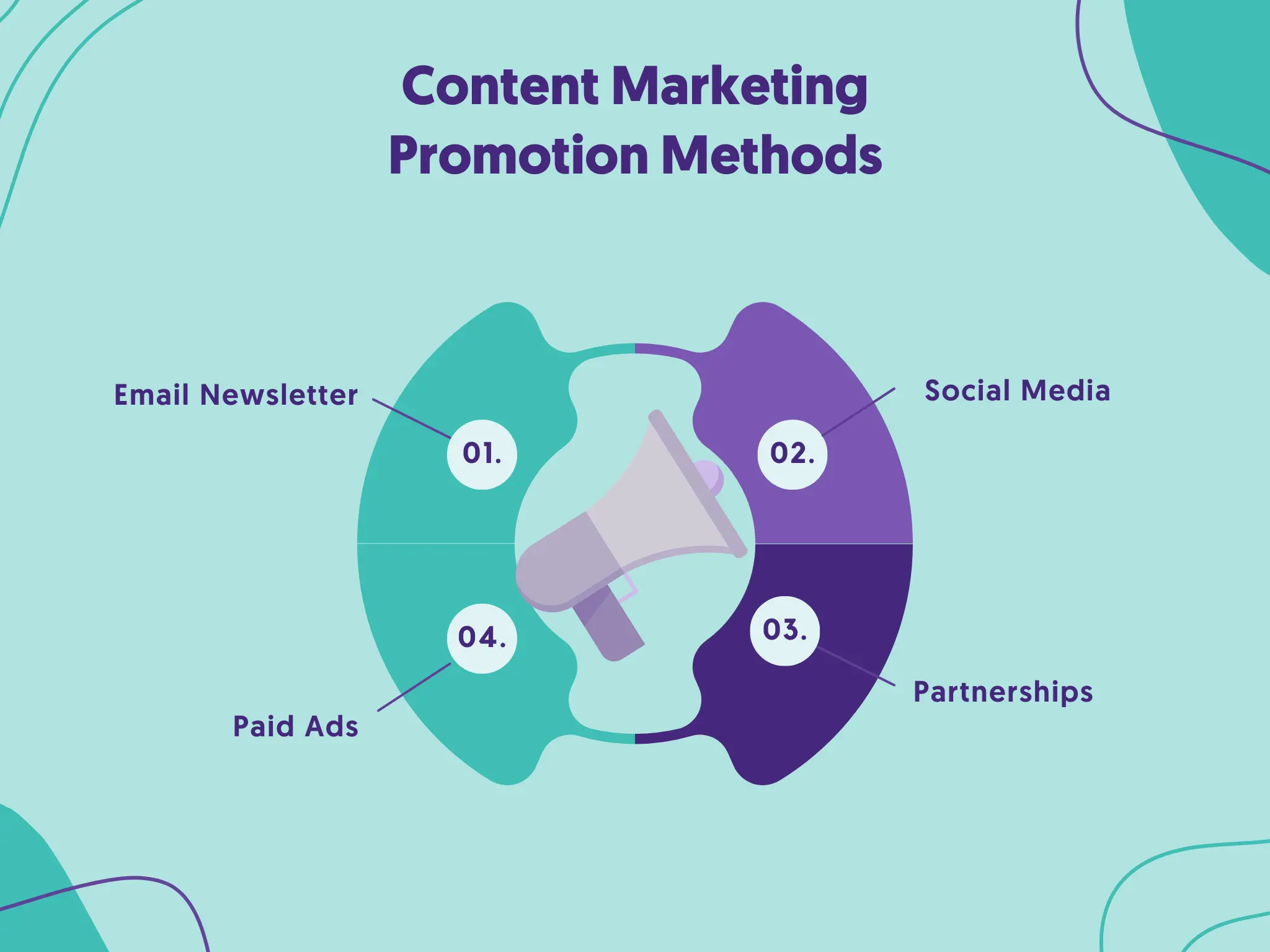
There are four types of channels to focus on:
Email Marketing
Email marketing is an owned media content distribution channel.
Many companies use email newsletters to build a relationship with their audience and deliver their content into their audience’s inboxes.
The best thing about this strategy is that you’re communicating with people already familiar with your brand.
Paid Advertising
Paid content promotion channels involve platforms that you’ll have to pay to promote your content.
Common paid advertising channels include Google Ads and Facebook Ads.
Social Media Marketing
Social media is one of the most powerful marketing channels. Big brands invest a lot of their time and big budgets in social media marketing.
You can leverage your social media pages to promote your content and reach a wider audience.
While most brands focus on only posting on their pages, you can gain a competitive edge by also promoting your content on Facebook and LinkedIn groups.
Social media groups, especially niche-specific ones, tend to have thousands of members.
Finding relevant groups will give you access to these followers and help you increase your audience.
Don’t forget to add value to other people’s posts by commenting. This can help your pages gain more traction.
Partnerships
Partnering with other authoritative websites in your niche is a great way to distribute your content.
Common partnership channels include guest blogging and sponsored posts.
These channels give you access to the host site’s audience and raise awareness for your brand.
Besides, these tactics help you build robust long-term relationships with big industry brands.
To maximize the potential of guest blogging and sponsored posts, focus on relevant websites in your industry. You can narrow down to sites that post related content topics.
8. Track KPIs to Gauge Effectiveness
The most successful content marketing strategies are continuously reevaluated.
For starters, you can evaluate your content strategy each quarter to see whether it still aligns with your business objectives.
Here are some examples of KPIs you can track:
Website Traffic - You’re likely going to use a combination of several platforms and channels to market your content. You need to track the traffic you’re getting per channel so that you can see what’s working better and invest more.
Organic Traffic - Track the traffic coming directly from search engines.
Engagement Rate - the percentage of people that engaged with your content (click a link, submit a form, stay on your website for xx minutes, etc.).
Conversions - Your content might be getting thousands of views every month, but what matters at the end of the day is the conversion rate. Tracking your content conversion rate can help you see which pieces generate the most sales.
Bounce Rate - Bounce rate is the number of visitors who leave your website without viewing any other page. If your website has a high bounce rate, then your content isn’t engaging enough, or your site’s user experience needs some work.
Ensure you keep your bounce rate as low as possible to help you retain your target audience’s attention.
Examples of Starups that Succeeded with Content Marketing
Here are three examples of startups that succeeded with their content marketing:
SEMrush

It shouldn’t be surprising that a company that provides digital marketing solutions is our first example of a successful content marketing strategy.
Over the last 4 years, they managed to increase their organic traffic to almost 1M users per month.
They did this by developing a strong educational content strategy involving courses, blog posts, videos, and webinars that not only show their users how to use their tools but also teach them how they can understand and implement SEO practices on their own.
Shopify
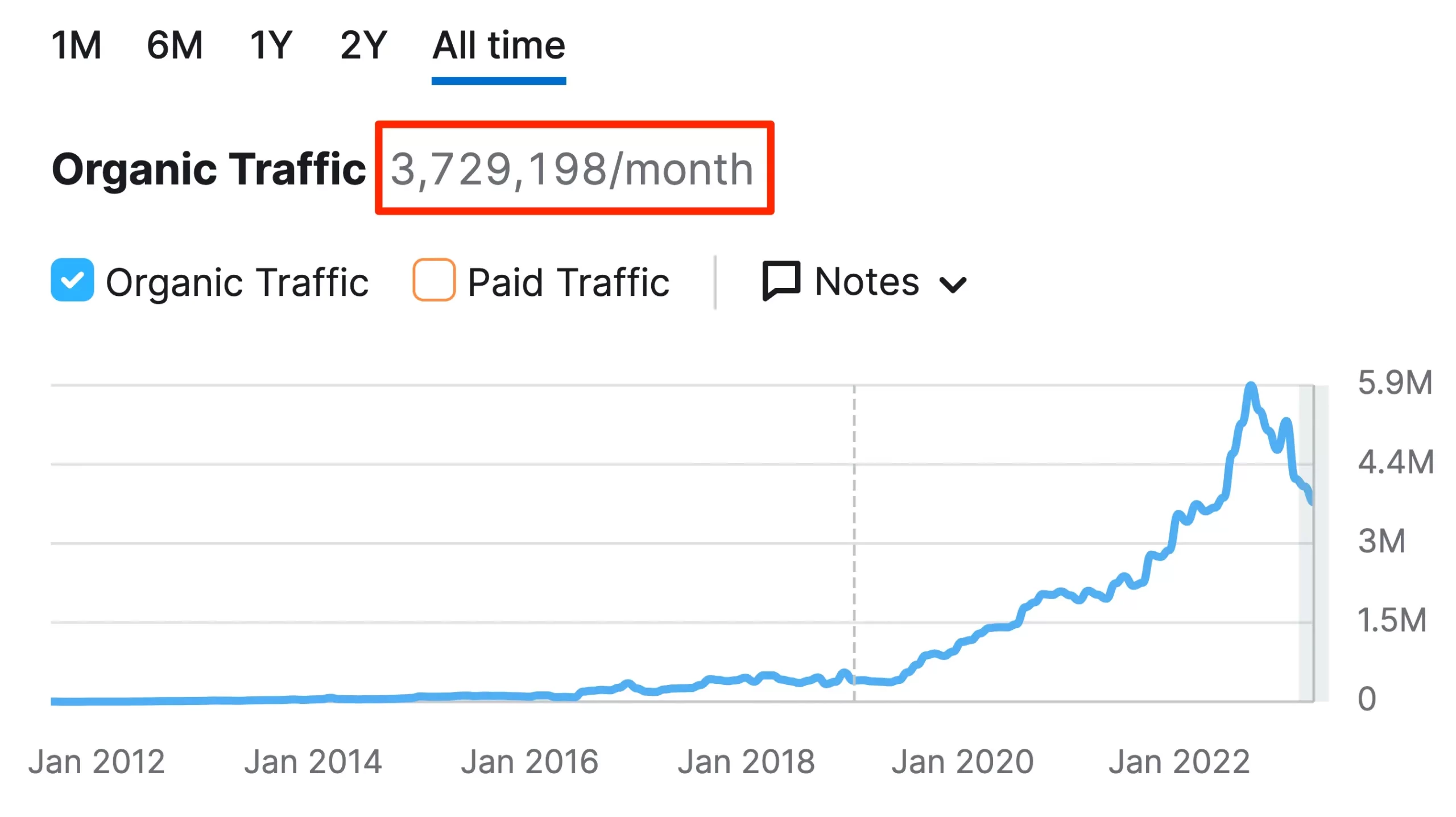
Over the last 3 years, Shopify has been consistently publishing valuable and in-depth guides on their blog.
They grew their traffic to an amazing 3.7M per month, and they rank on Google for many terms related to eCommerce and starting an online business.
Their strategy also helps the brand build trust between them and their customers since the content helps their users grow and succeed in their businesses.
Coursera

Coursera’s content strategy is a good example of how to use content to succeed in the e-learning industry.
Coursera used high-quality content, including blog posts, free courses, and webinars, to establish itself as a reliable source of online education.
As a result, they rank for thousands of keywords related to certifications and courses.
Conclusion
A well-designed content marketing strategy for startups has been proven to help brands increase organic traffic and boost sales.
You can leverage this strategy to produce high-quality content, establish yourself as an expert in your industry, and help your startup achieve its business objectives.
As we always say, content marketing is a marathon, not a sprint. Keep refining your strategy to actualize your startup’s potential.



